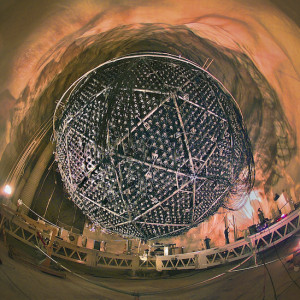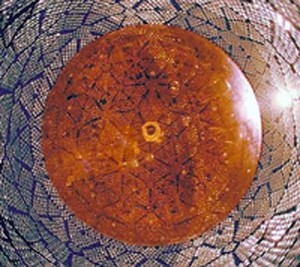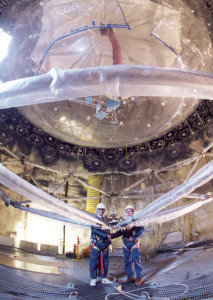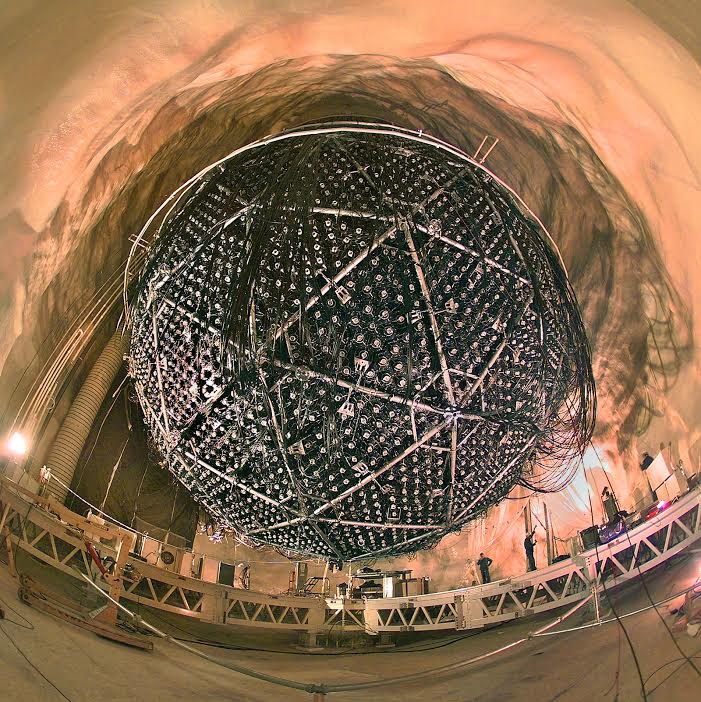“We’re very grateful to Berkeley Lab for its major contributions to the SNO project.” – Nobel laureate and SNO director Arthur McDonald

The 18-meters-in-diameter stainless steel geodesic sphere that housed the Sudbury Neutrino Observatory (SNO)’s photomultiplier tubes was designed at Berkeley Lab. (Photo by Roy Kaltschmidt)
Nobel Prizes in science can be shared by no more than three individuals, a restriction that can often overlook the work of a great many others whose own efforts helped make the prize-winning discovery possible. This year’s Nobel Prize in Physics was shared by Japan’s Takaaki Kajita and Canada’s Arthur McDonald for their key contributions to experiments which revealed that the ghostlike elementary particles called neutrinos have mass and are polymorphous. These experiments were carried out by large, multi-national collaborations: the Super-Kamiokande (Super-K) Collaboration in Japan, and the Sudbury Neutrino Collaboration (SNO) in Canada. The Nobel Prize-winning neutrino research carried at SNO has roots in Berkeley Lab where scientists and engineers played key roles right from the start.
The Missing Solar Neutrinos
Neutrinos are the second most numerous particle in the universe after photons and are often described as “ghostlike” because trillions pass through your body every second with no more effect than a fleeting thought. Emitted as the result of thermonuclear reactions in the core of the sun and supernovas, neutrinos are electrically neutral and interact with other particles only through the weak nuclear force, which makes it a challenge to observe and study them. Based on the Standard Model of Particles and Fields which has been the theoretical bedrock for explaining fundamental physics since the 1970’s, it was long held that neutrinos had no mass – all the more reason to label them as ghostlike. However, the notion of a massless neutrino raised a question that vexed scientists for nearly three decades.
Under the Standard Model, neutrinos come in one of three types or “flavors” – electron, muon and tau. Electron neutrinos are by far the most common and are produced within the core of the sun at the rate of more than two hundred trillion trillion trillion every second – a number that pales before the output of a supernova. However, neutrino detectors were recording far fewer solar electron neutrinos than they should have based on theoretical predictions and what scientists know about thermonuclear reactions. Where were the missing solar neutrinos? One hypothesis proposed that some of the solar neutrinos were “oscillating” or changing flavors from the electron neutrino to the muon or tau neutrinos in route from the sun to the earth. Such oscillations, however, would require that neutrinos have at least some mass. In 1983, scientists proposed the construction of an underground neutrino detector in an Ontario nickel mine that would be the first ever capable of simultaneously measuring all three neutrino flavors.
Telescope in a Cave

An interior view, looking up from the bottom, of one of SNO’s nearly 10,000 ultra-sensitive photomultiplier tubes that form a snakeskin-looking sheath around the detector’s geodesic sphere.
(Photo by Roy Kaltschmidt)
SNO can be thought of as a type of telescope even though it is located in a cave more than a mile underground and bears little resemblance to the image most people associate with that word. Starting in 1989, with funding support from the Office of Nuclear Physics within the U.S. Department of Energy (DOE)’s Office of Science, Berkeley Lab physicist Kevin Lesko, then with the Nuclear Science Division (NSD) led a team of scientists and engineers from NSD and the Engineering Division (ED) in the design and development of SNO. The SNO “telescope” would eventually consist of an 18-meters in diameter, stainless-steel geodesic sphere suspended in a huge pool filled with purified water. The outer surface of the geodesic sphere was fitted with a total of 9,456 ultra-sensitive light-sensors called photomultiplier tubes (PMTs). Inside the sphere was an acrylic vessel filled with heavy water (deuterium oxide. When a neutrino passed through the heavy water and interacted with a deuterium atom, a flash of light called Cherenkov radiation would be emitted. The PMTs would detect these light flashes and convert them into electronic signals that scientists could analyze.
“As it was vital that we detect as many light flashes as possible, we had to squeeze as many PMTs as possible onto the geodesic sphere while maintaining an adequate layer of water shielding between the tubes and the cavity walls of the SNO site,” Lesko has said.
The need for densely packed PMTs was complicated by the requirement that each PMT be individually aimed and that the entire assembly be water-tight. The design demands were made even more difficult because the components making up the PMTs came from several different countries.
To meet this multifaceted challenge, Gary Koehler, then with ED and the SNO project’s senior designer, “tessellated” the surface of the sphere with 751 panels that came in five different shapes, each of which was built up from repeating patterns of hexagons. The result was a honeycomb pattern that covered 70 percent of the sphere with PMTs and their reflectors.
A mounting system was also needed that would allow easy alignment of the panels and give SNO’s spherical structure the flexibility to go from being empty to being flooded with water. ED’s Yoichi Kajiyama, who was the SNO project’s mechanical engineer, working under Peter Purgalis, Berkeley Lab’s lead engineer on the SNO project, and with mechanical designer Dave Beck, assisted Koehler on this aspect of the design. Their solution was a three-point ball and socket mount that permitted each panel to be aimed by hand according to positions pre-set by computer, and provided stability to the sphere whether it was empty or full. In addition, they connected the entire collection of panels through a series of corrosion-resistant plastic skirts that made the sphere 99.95 percent water tight. The geodesic sphere was assembled in 1993 at Donal Machine in Petaluma, California. After it was successfully tested, it was disassembled and shipped to Sudbury. The Berkeley team oversaw installation of the PMT support structure beginning in 1997. The installation team was lead by Lesko, Milt Moebus and Steve Turner. SNO began collecting data in 1999.
Mystery Solved
On June 18, 2001, the first physics results from SNO were announced. After more than a year’s worth of data, much of which was analyzed at the National Energy Research Scientific Computing Center (NERSC), a DOE Office of Science user facility hosted at Berkeley Lab, SNO results showed that solar neutrinos do in fact undergo a metamorphosis in flavor during their 93 million mile journey to Earth, which meant they must have mass. In combination with experimental data from the Super-K detector and another neutrino detector in Japan called “KamLAND,” the mystery of the “missing” solar neutrinos had been solved.

Berkeley Lab’s Kevin Lesko and Milt Moebus in 1997 at the installation of SNO more than a mile underground in a nickel mine outside of Ontario, Canada. (Photo by Roy Kaltschmidt)
“We’re very grateful to Berkeley Lab for its major contributions to the SNO project,” said McDonald, director of SNO and newly minted Nobelist. “These contributions extended from the responsibility for the big geodesic dome to support the light sensor array, led by Kevin Lesko, through defining and maintaining cleanliness conditions in the laboratory, assaying materials with excellent sensitivity for radioactivity, and playing a major role in the physics analysis including an Analysis Coordinator role for (NSD physicist) Alan Poon. These contributions and many others by the Berkeley Lab team were absolutely essential for the success of SNO and are greatly appreciated by me and the rest of the SNO collaboration.”
In addition to Lesko and Poon, other NSD scientists contributing to SNO research included Marc Bergevin, Yuen-Dat Chan, Xin Chen, Charles Currat, Jason Detwiler, Michael Dragowsky, Noel Gagnon, Azriel Goldschmidt, Reyco Henning, Maria Isaac, James Loach, Alysia Marino, Ryan Martin, Martin Moorhead, Eric Norman, Colin Okada, Yekaterina Opachich, Gabriel Orebi Gann, Gersende Prior, Jason Pun, Sarah Rosendahl, Anett Schülke, Alan Smith, Robert Stokstad and Patrick Tsang.
Although SNO was shut down in 2006, the data gathered during its seven year run is still being analyzed. For example, NSD’s Gabriel Orebi Gann is using SNO data to measure the lifetime of neutrinos. She is also investigating whether the sun emits anti-neutrinos, the antiparticle of neutrinos. In the cave that housed SNO, construction of a new neutrino detector is now underway. This new detector is called SNO+ and once again a Berkeley Lab team, led by Orebi Gann, is contributing.
Neutrinos Still Keen Subjects of Interest
While the mystery of the missing solar neutrinos has been solved, neutrinos remain the subjects of keen scientific interest. For example, an experiment called the MAJORANA DEMONSTRATOR (MJD) project is underway at the Sanford Underground Research Facility (SURF) in South Dakota, with the goal of answering one the most persistent and momentous questions in physics: are neutrinos their own antiparticles? Berkeley Lab researchers are contributing to this research as well as to another international search for Majorana neutrinos, this one taking place in Italy, called CUORE, for Cryogenic Underground Observatory for Rare Events. Yet another neutrino telescope is buried under the ice cap of the South Pole. Dubbed “IceCube,” this neutrino telescope is being used to study yet another scientific mystery, that of the “cosmic accelerators,” the sources of rare ultra-high energy cosmic rays. Again, Berkeley Lab researchers have been playing a critical role in this effort.
The existence of neutrinos was first suggested in 1930 by physicist Wolfgang Pauli to explain the loss of energy that occurs when neutrons decay. At the time he joked, “I have postulated a particle that cannot be detected.”
Pauli was right about the existence of neutrinos but wrong about the ability of scientists to detect them. Just ask Nobel laureates Takaaki Kajita and Arthur McDonald.
Additional Information
For more about the 2015 Nobel Prize in Physics go here
For more about the Sudbury Neutrino Observatory go here
For more about Berkeley Lab’s Nuclear Science Division go here
